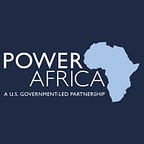Power in Beauty: Turning Waterfalls into Watts in Rural Kenya
Photos by Morgana Wingard
At the edge of Mt. Kenya National Forest, secluded by dense wilderness, is the rural Kenyan market center of Mutunguru. Those who live in the small villages surrounding Mutunguru enjoy stunning views of green valleys, lush forests, and idyllic waterfalls. But these features have also isolated residents from main roads, and limited access to electricity.
The rivers and waterfalls in this region of Kenya offer more than a pretty view. They hold vast potential to power communities and improve lives.
Recognizing this, a group of Mutunguru leaders rallied the community to find a partner to help build a run-of-the-river hydropower plant in their valley. Instead of bringing in donors, the reason an earlier power project never took flight, they looked for investors. The community leaders applied for grants and conducted feasibility studies, and eventually caught the eye of Virunga Power, a Power Africa partner and founding member of Power Africa’s Beyond the Grid sub-initiative.
Virunga Power was interested in building a hydropower plant to electrify this valley of Kenyan farmers. So, they applied for project support from the U.S.-Africa Clean Energy Finance Initiative (ACEF), an innovative financing program that helps spur private sector investment in clean energy projects in Africa.
In 2014, Virunga Power was awarded $295,000 in ACEF project preparation support to assist with the analysis, engineering, and legal work needed to jumpstart development.
Virunga Power and their partners at the Mutunguru United Hydro Power Project — a Community-Based Organization formed by the small-scale farmers in the area — will create a grid-connected hydro plant on the edge of the Mutonga River (pictured above) capable of producing 7.8 megawatts (MW) for the Mutunguru community. The community leaders’ success means that these rural villages could have access to reliable and sustainable electricity, many for the first time.
Virunga Power’s Managing Director, Brian Kelly (above, left), hopes that once everything is up and and running, the project will bring new connections to 5,000 households, which means that about 25,000 people will have access, and supply excess power to the national grid. Virunga Power’s goal is to provide enough power to not only light-up homes and recharge cell phones, but also to power businesses and equipment for smallholder farms across the rural communities where the company works.
Sammy Mwangi (above, right), a Virunga Power engineer who was born near Mutunguru and knows the residents and markets intimately, says increased access to electricity would bring big benefits to the shop owners, milk processors, and tea and coffee producers in the area.
However, the Mutunguru project is just the beginning, as Virunga has a goal to supply over 50 megawatts and connect 150,000 households in the region by the year 2020. And just as with Mutunguru, Virunga’s partnership with Power Africa will help attract other sources of private sector investment to improve lives in rural Kenya and across the region.
This story from Mutunguru exemplifies how Power Africa’s “business as usual” is anything but. Indeed, Power Africa is uniquely able to put the pieces and players in place to make projects like this one come to life.
For more on how Power Africa is connecting millions of homes and businesses across the continent to more reliable and affordable electricity, check out the Power Africa Roadmap, a guide to reaching President Obama’s goals of 30,000 MW and 60 million connections by 2030.
